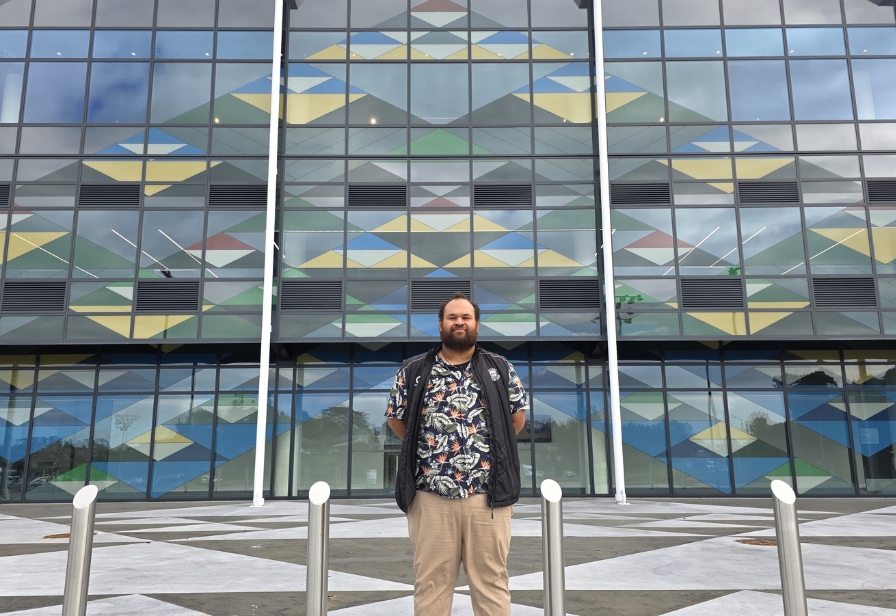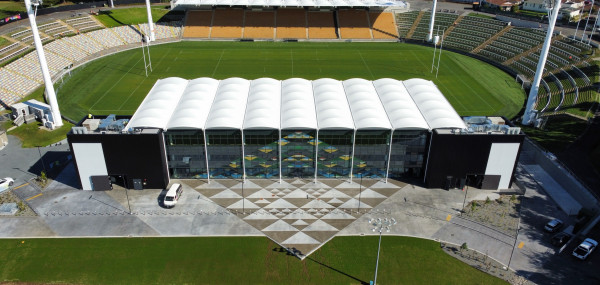The iconic view of Taranaki Maunga reflected in the Pouākai Tarns and the flow of rivers from the mountain to the sea have provided the inspiration for the design narrative of the new East Stand at Stadium Taranaki.

Kerehama Waru Te Pū with his design at the rear of the new East Stand.
This design has been led by Ngāti Te Whiti, providing an identify for the stand which has been rebuilt as part of Taranaki Regional Council's redevelopment project to create the best regional stadium in Aotearoa/New Zealand.
Kerehama Waru Te Pū worked on the narrative for five years, collaborating with members of his hapū who passed on their knowledge of the area to shape the design with a focus on how the stadium can bring the whole community together.
New Plymouth-born Mr Waru Te Pū, a graphic designer who works as a freelance artist and cultural monitor, says developing the concept to the completion of the project has been a collaborative effort involving his hapū, Boon architects, contractors, TRC and New Plymouth District Council.
“We started by looking at the location and the history of the area and what it was used for. Sketches by Frederick Carrington showed the area was a tributary swamp catchment of the Huatoki Stream and that link to water and the environment became the main focus,” says Mr Waru Te Pū.
“This was reinforced by working with Damon Ritai at the hapū and hearing about the history of the Huatoki and the Poukaka Pa and Maratahu Pa, and a brief history of the environment.
“Referencing back to that focus on water, the main design on the East Stand is of Taranaki Maunga on the building and the reflection is on the concourse, reflecting the view of the Maunga from the tarn. That’s the inspiration for the design.”
Mr Waru Te Pū says each point in the design represents the different maunga tipua (different peaks) with the reds in the lower section representing the Pouākai Range and other peaks. Whites represent snow, blues are water melted by the sun (the yellows), reinforcing the connection with water as it moves from the Maunga to the moana (sea).
“There are also connections to harakeke or weaving which was a highly prized thing in Taranaki and that’s part of the history and environment we’ve focused on.”
The design narrative continues on the interior of the stand with windows and doors repeating the patterns on the exterior of the buildings while the rivers on the walls of level one have been directly sketched from Carrington’s original drawings of rivers and streams in the area.
“I hope that someday this design narrative can extend to other parts of the stadium,” added Mr Waru Te Pū.
Ngāti Te Whiti Chairman Shelton Healey says: "It has been a privilege for Ngāti Te Whiti to help shape the design and identity of the new East Stand. It’s a reflection of our whenua, our waters, and our stories.
"We see this as a modern expression of our history and look forward to our narrative continuing to flow through future developments not only at the stadium, but throughout Ngāmotu New Plymouth"
TRC Chair Craig Williamson thanked Ngāti Te Whiti for their extensive mahi and praised Mr Waru Te Pū’s design for giving the East Stand a strong identity.
“The completed East Stand is an outstanding facility for the people of Taranaki and the vital contribution Ngāti Te Whiti has made has absolutely enhanced the completed stadium,” says Mr Williamson.
“Using the view of the Maunga reflected in the Pouākai Tarns was an inspired choice and really makes the stand unique to our region and our amazing environment.
“We’re extremely grateful to Ngāti Te Whiti for their continued support and we believe working together on this project has strengthened our ties with the hapū.”
Stadium Taranaki: Fast facts
- The stadium is owned by Taranaki Regional Council via the Taranaki Stadium Trust. It is run by New Plymouth District Council.
- The final budget for the redevelopment of the stadium was $79.7m, with the final cost of the project expected to be under this.
- The total contribution by Taranaki ratepayers remains under $50m, the same amount approved in 2019 after the public consultation and engagement process.
- TRC secured $30m in funding from the Government’s Infrastructure Reference Group Fund.
- The development included earthquake-strengthening the West Stand and the addition of a new roof on this stand.
- The original East Stand could not be repaired so was demolished and a new stand has been constructed.
- The steel piles in some areas go as deep as 30 metres into the ground.
- It has been built by New Plymouth-based Clelands Construction as the main contractors and a significant number of local skilled sub-contractors.
- The facility has hospitality facilities and there’s more space for conferences and trade shows.
- There are improved changing facilities for teams and match officials.

The East Stand's design draws inspiration from the view of Taranaki Maunga reflected in the Pouākai Tarns. Photo: Clelands Construction